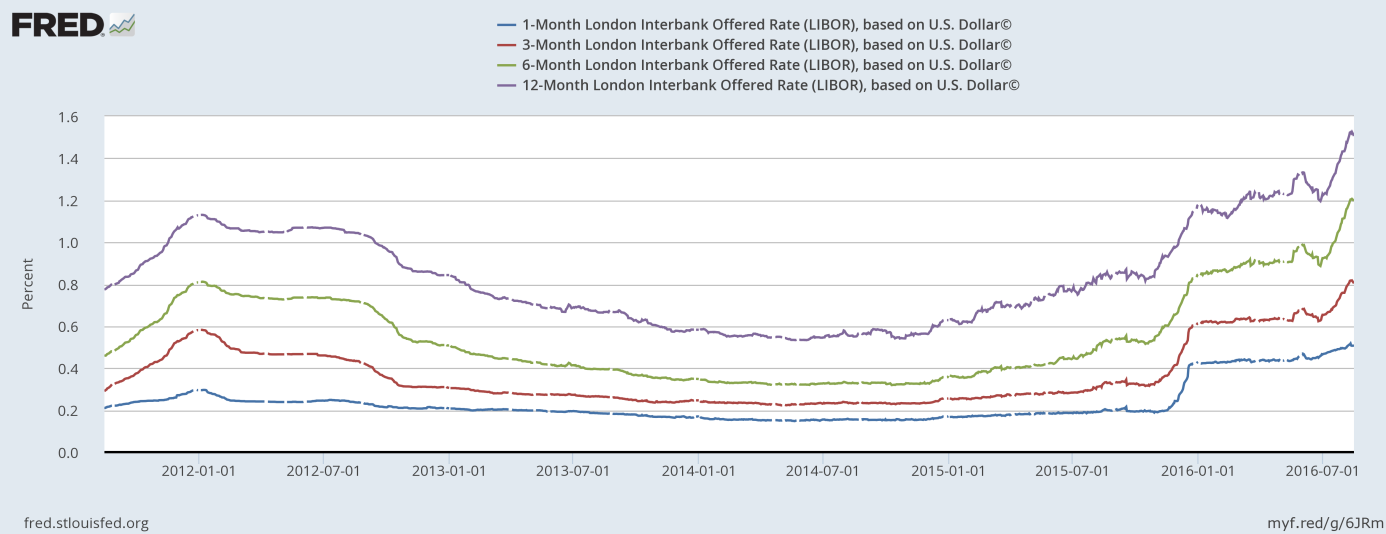On Monday, Libor hit a 7-year high. What does it mean for the Fed’s stance and the gold market?
The London Interbank Offered Rate based on the U.S. dollar has recently been rising, as one can see in the chart below.
Chart 1: The 1-month USD Libor (blue line), the 3-month USD Libor (red line), the 6-month USD Libor (green line) and the 12-month USD Libor (purple line) from August 2011 to August 15, 2016.

Why Libor is rising when most interest rates are falling? Well, it may signal some system stress (remember 2008, when Libor spiked?), but the more probable reason are new regulations. According to new U.S. money market rules that will take effect on October 14, shares of money-market funds will have to float in value, in contrast to the stable $1-a-share value money-market funds have traditionally maintained. Consequently, investors have started shifting money away from prime money-market funds in anticipation of the rule change. This repositioning in money market funds probably led to the recent jump in Libor.
Does it mean that there is nothing to worry about? Not necessarily. Actually, the recent FOMC minutes show that the Fed is aware of the risk associated with the rise in Libor rates.
“Although upcoming regulatory changes were expected to improve the stability of money market funds in the longer run, the staff noted the potential for large withdrawals by investors in anticipation of those changes to lead to some disruptions in the short run”.
The main problem is that the Libor rate affects a lot of consumers, since most loans, such as adjustable rate mortgages, are linked to Libor. It means that market conditions have tightened. This is good news for the gold market, since the Fed is less likely to hike the federal funds rate when Libor has already risen. However, there are no signs of a slowdown in consumer spending or other indices. Actually, new-home sales surged to an 8-year high in July.
To sum up, the London Interbank Offered Rate based on the U.S. dollar has recently been rising. These moves probably reflect a reaction to the new SEC rules on money-market funds, not market stress. But no matter what the reason is, higher Libor rates mean that interest rates have risen. We will see whether Yellen says something about the rising Libor rates in Jackson Hole, as the tightened market conditions could incline the Fed officials to remain cautious. The continuation of the dovish stance and a flatter expected path of the federal funds rate should support the price of gold.
If you enjoyed the above analysis, we invite you to check out our other services. We focus on fundamental analysis in our monthly Market Overview reports and we provide daily Gold & Silver Trading Alerts with clear buy and sell signals. If you’re not ready to subscribe yet and are not on our mailing list yet, we urge you to join our gold newsletter today. It’s free and if you don’t like it, you can easily unsubscribe.
Disclaimer: Please note that the aim of the above analysis is to discuss the likely long-term impact of the featured phenomenon on the price of gold and this analysis does not indicate (nor does it aim to do so) whether gold is likely to move higher or lower in the short- or medium term. In order to determine the latter, many additional factors need to be considered (i.e. sentiment, chart patterns, cycles, indicators, ratios, self-similar patterns and more) and we are taking them into account (and discussing the short- and medium-term outlook) in our trading alerts.
Thank you.
Arkadiusz Sieron
Sunshine Profits‘ Gold News Monitor and Market Overview Editor
Gold News Monitor
Gold Trading Alerts
Gold Market Overview


